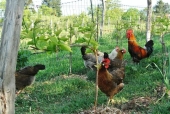The close relative of the artichoke, Cardoon, has apparently been used as fodder.
'Capable of growing in most soil conditions, self-seeding prolifically, long-lived and able to withstand drought, the cardoon was used as food, as an herbal medicine and as fodder for livestock.
In fact, the plant can be used in its entirety. "The leaves make a wonderful
compost with a high nitrogen content," says Katarina Eriksson, head gardener of the perennial gardens at the Huntington Botanical Gardens in San Marino. "In some places, like Russia, they use it as a fuel. The dried stalks are used for kindling. The dried flowers can be used as a rennet for making cheese."'
http://articles.latimes.com/2005/jul/14/home/hm-cardoon14 High nitrogen content means high protein, so should be a good fodder crop.
http://www.nutrientfacts.com/FoodPages/nutritionfacts/nutritionfacts_Cardoon.htm I can't find nutrition information about the leaf parts of artichoke, just the bud, but I'm leaping to the conclusion they are similar to cardoon.








